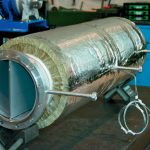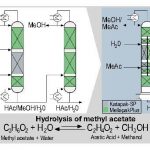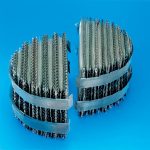Combining processes and reducing the size of installations is one way of reducing costs in chemical process engineering. Examples include the reactive distillation process where a reaction and separation are simultaneously carried out or the use of divided wall columns that can replace two conventional distillation columns. One highly integrated option is a reactive distillation process that is conducted in a divided wall column. This complex process is now being researched within the EU Insert project in cooperation with industry partners and universities.
Stefan Sander
Reactive distillation is especially advantageous in the case of equilibrium reactions in which the conversion of the reactants is limited due to the chemical equilibrium. As the products are removed in the reaction zone, it is possible to achieve an improved conversion process using a single piece of equipment. Reactive distillation columns contribute to process integration, allow more efficient use of resources and reduce investment and operating costs. If reactive distillation is carried out in a divided wall column, a process that previously required one column for reactive distillation plus another, conventional distillation column can be implemented in a single tower. With some reactions, this integration generates increased product purity while significantly lowering the above-mentioned costs. In the framework of the Insert project, Sulzer Chemtech has conducted experimental research into the development of reactive divided wall columns. At the company’s laboratory in Winterthur (Switzerland), a distillation column (diameter 220 mm) was fitted with dividing walls and used as a reactive divided wall column.
Reduced residence time
The hydrolysis of methyl acetate, which produces methanol and acetic acid, served as an exemplary reaction. This is an important process in the production of polyvinyl acetate, during which methyl acetate is generated as a by-product. The methyl acetate is transformed into acetic acid and methanol before being fed back into the production process. One disadvantage of the current reactive distillation process is that all products and unconverted water exit the reactive distillation column via the sump and are then separated in downstream columns. Owing to the residence time in the sump and piping, reverse reactions are possible, making it difficult to produce methyl acetate-free methanol. By combining the reactive distillation and the subsequent separation in one reactive divided wall column, the number of columns can be reduced and the residence time of the newly formed products kept to a minimum, thus suppressing the reverse reaction.
Separation process
The top and bottom sections of the column have no dividing wall and are filled with MellapakPlus. A wall divides the middle section of the column. The left side – the reactive side – is filled with Katapak-SP packing, while the right side contains MellapakPlus. The packing elements were specially manufactured for the purpose of these tests. The ring channel of the collector is also divided and the liquid is fed via two pipes to the distributor, which is situated below. The reactants are fed into the Katapak bed from above (water) and below (methyl acetate in a pure form or mixed with further components). The reaction subsequently occurs in the Katapak bed. The methanol which is produced exits the bed at the bottom along with the acetic acid and the non-reacted water. On the non-reactive side, the methanol mixture rises and is further separated until methanol of the greatest possible purity is extracted as side product stream.
Successful trials
Sulzer Chemtech operated the column installed in connection with this project in shifts and performed a total of eight trials. It was possible to achieve stable operation of the reactive divided wall column for the hydrolysis of methyl acetate, and the resulting products fulfilled all expectations. It was also demonstrated that the design and operation of a reactive divided wall column requires an exact knowledge of both the efficiency and the hydraulics of the packing elements and the reactions involved. The tests demonstrated that complex column designs such as a reactive divided wall column can be installed and operated successfully. The test column is particularly suitable for investigating separation tasks that clients would like to carry out in packed divided wall columns. As a result of its flexible configuration, it is also ideal for examining new process variants. Following the evaluation of the tests, it will be possible to simulate process variants which enable higher methanol purities and yields to be generated. As soon as the calculations have been completed, the results can be verified in further pilot tests. Based on this research, an alternative process for the hydrolysis of methyl acetate – involving a smaller number of columns and a reduced level of by-product formation – will be available.
cpp 429
Insert project
The goal of the Insert project is to develop further steps for the Integration of Separation and Reaction Technology. Fourteen partners, companies and universities from eight European countries, are jointly working on the succession project to the Intint project, in which Sulzer was also involved (see STR 1/2002, p. 14). It is being financed by the European Union (Project Insert; Contract No: NMP2-CT-2003–505862), the Swiss Federal Office for Education and Science, and the participating companies. Sulzer Chemtech is leading the experimental part of the project, in which six different systems were investigated. The work is focused on the examination of a reactive divided wall column. Its partners in this experimental research study are the University of Stuttgart (Germany), which has measured the kinetics of the reactions involved, and BASF Ltd., which has installed this type of column system on a laboratory scale.
Seperation technology
Literatur
Research
INTINT
Share:









